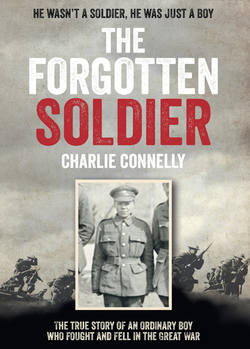Читать книгу The Forgotten Soldier: He wasn’t a soldier, he was just a boy - Charlie Connelly, Charlie Connelly - Страница 9
3 ‘A long, hard journey through a short, hard life’
ОглавлениеOne hundred and fifteen years after his birth, almost to the day, Edward Connelly’s locality looked quite different to the one he knew, especially on one of those spring mornings that make even the Harrow Road happy. There was the cheeriness of renewal everywhere – a freshness in the air; even the rattling rasp of the grilles going up at the bookmakers and money-transfer shops seemed to have a tangible jauntiness. The half-dozen people waiting for the post office to open smiled and chatted. Two men in bright-blue overalls with the legend ‘Love the Town You Live In’ written on the back of their hi-vis vests rumbled by, wheeling a bin full of brushes. As the sun climbed higher into the sky and forced the shadows into retreat towards the shop fronts, a young woman wearing a puffa jacket waiting in the post-office queue put her head back, closed her eyes and smiled to herself as the sunshine warmed her face. The sky was deep blue and cloudless, bare save for the swollen ghost of an aircraft contrail.
I ordered a cup of tea in a café, sat down at a Formica table, reached into my bag and pulled out a dog-eared copy of the London A–Z along with a folded map: a reproduction of an Ordnance Survey of the area from 1913. I found the right page of the A–Z and opened the old map, placing them side by side on the table, two landscapes divided by a century but whose urban contours made them recognisable as the same place. I ran my forefinger down the page of the A–Z and then did the same to the map until I found where I needed to go.
On the old map, Gadsden Mews is there in the east of Kensal Town, a wedge of North-West London still hemmed in today by the canal, the railway and Ladbroke Grove. Within this triangle on the old map, concentric streets of tightly packed houses shrink towards the very centre where, shoehorned into a cramped space between the backs of the residences, there are two rows of tiny squares named Gadsden Mews. There’s no Gadsden Mews on the A–Z, it’s long gone, but the surrounding streets survive and I could at least get close if I could find Hazelwood Crescent.
I drank my tea, headed back out into the sunshine, turned east along the Harrow Road, crossed the bridge over the canal and walked towards where Gadsden Mews used to be.
After crossing the canal I headed for the landmark of Erno Goldfinger’s Trellick Tower until I found Hazelwood Crescent nestling in its considerable shadow. The entrance to Gadsden Mews had been at a slight dog-leg kink in Hazelwood Crescent that’s still there today, so I’d be able to pinpoint almost exactly where the mews once lay. The streets were quiet as I reached the hint of a bend I was looking for. On this spot had been the only way in and out of the slum tenements, the tiny three-storey wooden houses packed with the poorest of the poor, where whole families often lived in single rooms with little in the way of comfort or sanitation. Kensal Town itself was a poor area, but even Kensal Towners would probably have looked down on Gadsden Mews.
I gauged my bearings and stood for a moment looking into where the entrance used to be. Ahead of me was Hazelwood Tower and to my right was the gable end of a low block of flats. I was about to move on when the sign on the front of the block of flats caught my eye – it was called Gadsden House. So there was an echo of the old place here after all. I walked around a little further, passed between a couple of apartment blocks and made my way into the centre of the Kensal New Town estate at the heart of which was a tarmacked basketball court bordered by a bright blue metal cage where the breeze moved a few leaves around in a far corner. The gate was open; I walked onto the court and stood at its centre. Hazelwood Tower dominated one end and on one side the court was overlooked by the balconies of Gadsden House. Somewhere beneath my feet lay the heart of Gadsden Mews. Somewhere here, within no more than a few feet of where I stood and where my shadow fell, was where my great-grandparents had eked out their lives of relentless hardship and poverty, and where Edward Connelly was born.
Ahead of me lay a long, hard journey through a short, hard life. Around 175 miles south-east of me, as the crow flies, was a small, neat, unvisited grave. I looked a little incongruous standing in the middle of an empty public basketball court on an estate in North-West London clad in full walking gear and rucksack, but this was where a story with a mysterious, tragic ending began. I was beginning my physical journey from the cradle to the grave, through the all-too-brief life of Edward Connelly. I took a last look around, shifted my rucksack into a more comfortable position, strode away from the basketball court and set out for Belgium.
